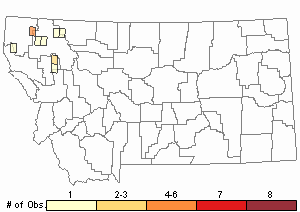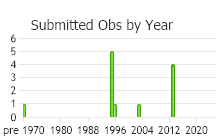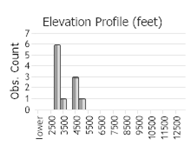View in other NatureServe Network Field Guides
NatureServe
Montana
Utah
Wyoming
Idaho
Wisconsin
British Columbia
South Carolina
Yukon
California
New York
Hamatocaulis Moss - Hamatocaulis vernicosus
Other Names:
Drepanocladus vernicosus
General Description
Plants: Medium to large in size, green, brown, a mix of green and red (seldom nearly all red) (FNA 2014), tufted. Stems 3-16 cm (Lawton 1971), more-or-less pinnately branched, lacking central strand; shoot tips frequently hooked; rhizoids near or at point of leaf attachment; upper cells of axillary hairs hyaline (FNA 2014).
Leaves: Stem leaves ovate, concave, distally bending into a sudden strong curve from a straight base, distinctly or occasionally weakly pleated, 0.6-1 mm in width, with transverse bands in the sub-basal area and occasionally larger areas of the leaf red; base more-or-less upright, a little narrowed at the insertion (slightly falcate), not extending down stem; apex tapered to a short-to-long point; margins entire or finely-toothed near tip (FNA 2014), flat below, rolled inward and upward above; costa single, extending beyond mid-leaf; branch leaves smaller but otherwise resembling stem leaves (Lawton 1971).
Leaf Cells: Alar region not distinct; medial laminal cell walls thin or sometimes a little thickened (incrassate), with or without pores (FNA 2014), longer than the basal cells (Lawton 1971).
Diagnostic Characteristics
The stem leaves that are (usually) strongly-pleated, with the abrupt curve distally and the upright base, make this species readily recognizable (FNA 2014).
Range Comments
Canada: AB, BC, MB, NT, ON, PE, QC, YT; USA: AK, CT, IL, IN, ME, MI, MN, NJ, NY, OH, OR, VT, WA; West Indies (Dominican Republic); n South America (Columbia, Venezuela); Eurasia. Elevation: 0-4600 feet (FNA 2014). Known in Montana from Flathead, Gallatin, Glacier, Lake, and Lincoln Counties (Elliott 2016).
Observations in Montana Natural Heritage Program Database
Number of Observations: 16
(Click on the following maps and charts to see full sized version)
Map Help and Descriptions
Relative Density

Recency



 (Observations spanning multiple months or years are excluded from time charts)
(Observations spanning multiple months or years are excluded from time charts)
Habitat
Organic soil in mineral-rich wetlands (Elliott 2016).
Reproductive Characteristics
Dioicous (FNA 2014). The capsule is long, the operculum cone-shaped, and the calyptra shaped like a monk’s hood and split along one side (cucullate) (Lawton 1971).
Stewardship Responsibility
References
- Literature Cited AboveLegend:
 View Online Publication
View Online Publication Elliott, J.C. and A.K. Pipp. 2018. A Checklist of Montana Mosses (1880-2018). Updated 3 January, 2020. Montana Natural Heritage Program, Helena, Montana. 73 pp.
Elliott, J.C. and A.K. Pipp. 2018. A Checklist of Montana Mosses (1880-2018). Updated 3 January, 2020. Montana Natural Heritage Program, Helena, Montana. 73 pp. Flora of North America Editorial Committee, eds. 2014. Flora of North America North of Mexico. Volume 28. Bryophytes: Mosses, Part 2. Oxford University Press, Inc., NY. xxi + 702 pp.
Flora of North America Editorial Committee, eds. 2014. Flora of North America North of Mexico. Volume 28. Bryophytes: Mosses, Part 2. Oxford University Press, Inc., NY. xxi + 702 pp. Lawton, E. 1971. Moss Flora of the Pacific Northwest. Hattori Botanical Laboratory. Japan: Yamabuki-cho, Shinjuku-ku, Tokyo. 362 pages plus appendices.
Lawton, E. 1971. Moss Flora of the Pacific Northwest. Hattori Botanical Laboratory. Japan: Yamabuki-cho, Shinjuku-ku, Tokyo. 362 pages plus appendices.
- Additional ReferencesLegend:
 View Online Publication
View Online Publication
Do you know of a citation we're missing? Elliot, J. C. 1993. Second checklist of Montana mosses. Unpublished report. U.S. Forest Service, Region 1. Missoula, MT. 45 pp.
Elliot, J. C. 1993. Second checklist of Montana mosses. Unpublished report. U.S. Forest Service, Region 1. Missoula, MT. 45 pp. Lawton, E. 1971. Keys for the Identification of the Mosses on the Pacific Northwest. Reprinted from 'Moss Flora of the Pacific Northwest'. Published as Supplement No. 2 of the Journal of the Hattori Botanical Laboratory. Nichinan, Miyazaki, Japan. 66 pp.
Lawton, E. 1971. Keys for the Identification of the Mosses on the Pacific Northwest. Reprinted from 'Moss Flora of the Pacific Northwest'. Published as Supplement No. 2 of the Journal of the Hattori Botanical Laboratory. Nichinan, Miyazaki, Japan. 66 pp.
- Web Search Engines for Articles on "Hamatocaulis Moss"





